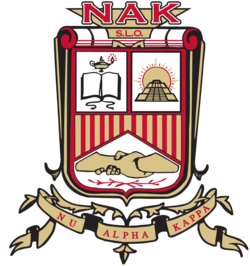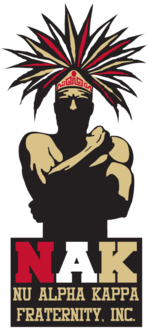Nu Alpha Kappa
| Nu Alpha Kappa Fraternity, Inc | |
|---|---|
| NAK | |
 | |
| Founded |
February 26, 1988 California Polytechnic State University, San Luis Obispo, CA |
| Type | Social |
| Scope | National |
| Motto | Men of Mind... Men of Culture... Men of Pride... |
| Colors |
Red White Bronze |
| Symbol |
Xinako Man  |
| Headquarters |
San Luis Obispo, California USA |
| Homepage | http://www.naknet.org |
Nu Alpha Kappa (ΝΑΚ), is a Latino-based fraternity which encompasses and values all cultures. Nu Alpha Kappa stands as one of the largest Latino-based fraternities on the west coast.
Often referred to as "NAK", Nu Alpha Kappa was founded on February 26, 1988 on the campus of California Polytechnic State University, with 26 established chapters across California, Nevada, and Colorado. Nu Alpha Kappa was a charter member of the National Association of Latino Fraternal Organizations (NALFO), but is now a member of the North-American Interfraternity Conference.
NAK's Mission Statement is as follows: "We, NU ALPHA KAPPA, seek to unite and involve all students in a more harmonious and brotherly atmosphere through academic, social and cultural means. There is a need to interface the various backgrounds that constitute the student body of our fraternal university chapter, in order to improve relations amongst all students and the community."
History
"Xinaco", a Nahuatl word used by the Olmecs, describes an educated, amiable individual whose personality and charisma transcends and enlightens all cultures and social classes. The "Xinacos" (CHI-Na-Kos) meeting resulted in the creation of a new fraternity. The foundations of the fraternity were started by fifteen good friends at Cal Poly San Luis Obispo, California, of which eleven would become founding fathers of the fraternity. This marked the beginning of Nu Alpha Kappa Fraternity, an organization based on the belief of a commitment to "Carnalismo" or brotherhood, the search for knowledge and the retention and pride of culture.
Nu Alpha Kappa was established on February 26, 1988 on the campus of Cal Poly San Luis Obispo by Antonio Arreola, Marin Arreola, Nicolas Arreola, Ernesto Garcia, Moises Herrera, Jesse Martinez, Hector Mendoza, Joel Romero, Alberto Salazar, Antonio Valenzuela, and Ramiro Ramos.
These Nacos wanted to demonstrate that they were an important part of the Cal Poly student body. They were enthusiastic about starting a club to help Latino students overcome the culture shock experienced when arriving at a predominantly Anglo university. As their excitement grew, they sought to create structure for their ideas. They decided to form a fraternal cultural organization.
Adapting the term 'Naco' to the university fraternity system, the group officially became Nu Alpha Kappa Fraternity, or NAK for short. Although choosing to adopt the formalized structure of the fraternity system, NAK was — and remains — determined to distinguish itself from traditional “frats” by maintaining a commitment to the ideals of academic excellence, cultural knowledge, and true brotherhood.
The pressures of being the first Latino-based fraternity at Cal Poly were significant. Despite having many supporters on campus, there were also many detractors who anticipated NAK’s demise. With steadfast determination, the brothers of NAK persevered.
National events
National Leadership Development Conference (NLDC) - A leadership development weekend which invites the executive board of each chapter, alumni and the National Board to convene on new policies and strategies for the upcoming academic year. Over 200 brothers come together to learn from each other and take back knowledge to their chapters and communities for a successful year. Workshops, discussions and lectures are conducted by National Board, NAK alumni, Campus advisors and administrators. Each year a different chapter has the opportunity to host this event during the late Summer.
Pledgefest - An opportunity to bring together all potential brothers, known as prospective members, from each chapter for a weekend of team building, leadership development and a large community service event. The experiences and memories incorporated throughout the weekend ignite the flame of brotherhood for the next generation of NAK brothers. Each year a different chapter has the opportunity to host this event during the late Fall.
NAKFest - An annual family reunion between alumni and undergraduate brothers which brings together the past with the present. A weekend event hosted by a different chapter each year which consists of the National Elections, Sports Tournament, Awards Banquet, and National Party. A one-day double-elimination sports tournament is held with all chapters, with the winner receiving a first round bye during the NSL tournament and year of bragging rights. A Spring time event which helps close out the academic year allowing brothers to network and continue to build upon the unseen bond of brotherhood.
NAK Sports League (NSL) - A year-long brotherhood event giving chapters the opportunity to network and convene in a friendly sports competition. A different chapter serves as hosts of the first round games between two chapters outside of their region. The Semi-Finals and Championship Game are concluded at NAKFest.
NAK Alumni Softball Tournament - An annual softball tournament among the NAK Alumni Associations. This weekend tournament typically involves the local alumni associations around NAK.
National philanthropy
The National Marrow Donor Program (NMDP), created in 1986, is a non-profit organization based in Minneapolis, Minnesota. Its mission is to extend and improve life through innovative stem cell therapies.
The Hispanos Dando Esperanza: Nu Alpha Kappa-Hermandad Initiative is dedicated to outreaching the Hispanic/Latino communities. This outreach to the Hispanic/Latino community demonstrates that the National Marrow Donor Program and Nu Alpha Kappa Fraternity, Inc. are committed to serving our cultural diversity U.S.A. This initiative promotes innovation and teamwork.
By incorporating these values, the National Head Program and Nu Alpha Kappa Fraternity, Inc. aspire to set a standard of excellence nationwide that rewards our recipients, donors, volunteers, and communities.
This Hispanic/Latino Stem Cell and Marrow Initiative focus efforts throughout California, Colorado and Nevada with 992 National Marrow Donor Program donor centers and 10 recruitment groups, including Nu Alpha Kappa Chapters.
Alumni
The NAK National Alumni Association was officially enacted in 2014. It will provide support for & advise all Nu Alpha Kappa Fraternity Undergraduate & Alumni members in their life-long commitment to the fraternity’s core ideals of Education, Culture & Brotherhood. The NAA will be committed to fostering interaction and strengthening the bonds of “carnalismo” amongst all members of Nu Alpha Kappa Fraternity. The NAA will promote civic and professional service by all members of Nu Alpha Kappa Fraternity. The NAA will utilize our powerful & expansive network to support & develop our local and regional alumni associations.
The purpose of the National Alumni Association shall be to encourage and provide support to Nu Alpha Kappa Fraternity. The NAA will advise, serve, inform and involve alumni of Nu Alpha Kappa Fraternity so as to foster interaction and brotherhood, promote civic & professional service and to create opportunities for lifelong fraternal engagement for Nu Alpha Kappa Fraternity members. All members of the National Alumni Association are encouraged to carry the principles and ideals of Nu Alpha Kappa Fraternity into their civic and business community and to provide leadership and service to those affiliations to the best of their ability. The National Alumni Association is the governing body of and National representative for the alumni of Nu Alpha Kappa Fraternity including the active local & regional alumni associations and active alumni members of Nu Alpha Kappa Fraternity’s National Alumni Association. The NAA shall serve as chief advisor to the President of the National Fraternity.
National chapters
Nu Alpha Kappa has established chapters across universities in California, Nevada and Colorado.[1]
See also
Notes
- ↑ "National Chapters". Retrieved November 24, 2013.